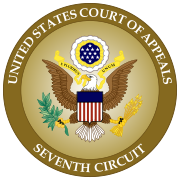User:Klueska/hovtaflove
| Ho v. Taflove | |
|---|---|
 | |
| Court | United States Court of Appeals for the Seventh Circuit |
| Decided | June 6, 2011 |
| Citation(s) | Ho v. Taflove (7th Cir. June 6, 2011), Text. |
| Court membership | |
| Judge(s) sitting | Kenneth F. Ripple and David F. Hamilton, Circuit Judges, and G. Patrick Murphy, District Judge (opinion signed by judge Elaine E. Bucklo) |
| Case opinions | |
| Summary judgment in favor of the defendants | |
Ho v. Taflove was a case in the United States Court of Appeals for the Seventh Circuit that tested the laws concerning the copyrightability of ideas vs. the expression of those ideas (the so-called idea-expression divide)[1]. This case was first decided in the United States District Court for the Northern District of Illinois on January 15, 2010[2], with that judgement affirmed by the Seventh Circuit Court of Appeals on June 6, 2011[3].
The plaintiffs in this case alleged that the defendants violated the Copyright Act by publishing equations, figures, and text from research materials originally produced by the plaintiffs. The court granted summary judgement in favor of the defendants, concluding that the plaintiff's research materials were unprotectable ideas under copyright law's merger doctrine, and thus no wrong doing was performed by the defendants when publishing a paper based on those materials.
Background[edit]
Seng-Tiong Ho and Allen Taflove are both professors in the Electrical Engineering and Computer Science department at Northwestern University. In 1998 Professor Ho formulated a "4-level, 2-electron atomic model with Pauli Exclusion Principle for simulating the dynamics of active media in a photonic device" [3]. Within a year, professor Ho had completed the necessary mathematical derivations of the model, writing all of his notes and equations in a set of notebooks consisting of approximately 69 pages of hand written text. Once these equations were complete, professor Ho tasked one of his graduate students, Shi-Hui Chang, with creating a computer simulation of the model, giving him access to his hand written texts and exposing him to a large amount of experience working with the model. Before completing the simulation, however, Mr. Chang decided to leave professor Ho's research group and join that of professor Taflove's. In the meantime, another graduate student, Yingyan Huang, joined professor Ho's group and continued the work left by Mr. Chang.
By the end of 2002, a short paper had been published by professor Ho introducing his model to the general public, and Ms. Huang had published a Master's thesis based on her work applying the model to different mediums. In 2003 and 2004 professor Taflove and Mr. Chang also submitted, and subsequently published, two articles directly related to professor Ho's model. The first paper only briefly mentioned the model, while the second one explained it in detail (including figures directly pulled from Ms. Huang's Master thesis). At no point, however, did professor Taflove or Mr. Chang attribute any of the content of their articles to either professor Ho or Ms. Huang.
In 2004 when professor Ho attempted to publish his first full paper on the model, his submission was rejected based on the grounds that work had already been published on this topic (namely the articles published by Mr. Chang and professor Taflove). To help validate his claim to the ownership of the model, in 2007 professor Ho and Ms. Huang filed for and received certificates of copyright for professor Ho's 69 pages of hand written notes describing the model as well as the full text of Ms. Huang's Master thesis and a visual presentation of the thesis.
On July 31, 2007 professor Ho and Ms. Huang filed suit with the United States District Court for the Northern District of Illinois claiming 33 counts of copyright infringement spread over 6 documents published by professor Taflove and Mr. Huang[2]. However, on January 15, 2010 the District Court granted summary judgement in favor of Mr. Chang and professor Taflove, concluding that the equations, figures, and text in professor Ho's notes and Ms. Huang's Master thesis were "unprotectable concepts, ideas, methods, procedures, processes, systems, and/or discoveries” [1] and that the merger doctrine is applicable because there are limited ways of mathematically expressing professor Ho's model.
On June 6, 2011, the United States Court of Appeals for the Seventh Circuit upheld this ruling on all counts.
Claims[edit]
Lower Court Proceedings[edit]
Appellate Court Ruling[edit]
Settlement[edit]
References[edit]
- Memorandum denying the plaintiff's motion to reconsider the grant for summary judgement.[4]
- Defendants' motion for attorneys' fees and other nontaxable expenses.[5]
- "In Their Opinion" Article on Ho v. Taflove.[6]
- "BNA" article on Ho v. Taflove[7]
Category:United States copyright case law Category:United States Court of Appeals for the Seventh Circuit cases
- ^ a b Subject Matter of Copyright: In General (17 U.S.C. § 102)
- ^ a b Ho v. Taflove: Motion for summary judgement, Granted January 15, 2010
- ^ a b Ho v. Taflove (7th Cir. June 6, 2011), Text.Appelate Court Decision
- ^ Ho v. Taflove: Motion to reconsider grant for summary judgement, Denied April 9, 2010
- ^ Ho v. Taflove: Motion for attorneys’ fees and other nontaxable expenses, Granted in part and denied in part December 20, 2010
- ^ "In Their Opinion" Article on Ho v. Taflove
- ^ "BNA" article on Ho v. Taflove

